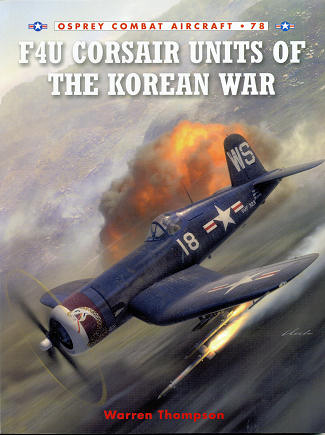 Finally,
after many years of waiting, we have a new 'Units of the Korean War' by Warren
Thompson. Not quite the same as the other half dozen books that were done in the
past, as those were considerably more image intensive and not, of course, in the
same series or format, but a book I'm quite pleased to see, nonetheless.
Finally,
after many years of waiting, we have a new 'Units of the Korean War' by Warren
Thompson. Not quite the same as the other half dozen books that were done in the
past, as those were considerably more image intensive and not, of course, in the
same series or format, but a book I'm quite pleased to see, nonetheless.
The Corsair was one of the few WWII aircraft types that was
kept in production after the war. While most other extant prop driven types were
scrapped or transferred to the Reserves or National Guard, the Corsair was
deemed to be handy enough to keep around. It was even improved upon with the
advent of the F4U-5 and the ground attack optimized AU-1. The -5 only saw
limited use in Korea and then only as a night fighter, while the AU-1 was
particularly effective, though only around a hundred or so were ever produced.
The book starts with the first ship on the scene carrying
Corsairs, the relatively new USS Valley Forge and her air wing, CVG-5.
It is interesting to note, the air wing 5 is the one that was forward deployed
with the USS Midway back in the mid 1970s and is still in Japan at this time.
Thus began a series of deployments by a number of aircraft carriers including
the Philippine Sea, Boxer, Essex, Princeton, Leyte and others with some making
multiple deployments. Each carried at least one squadron of Corsairs and many
had more. These aircraft were primarily used in the ground attack role and
almost always operated from the ships. When it came to land based Corsair
operations, that was when the Marines were called into action, with several
units assisting the troops and in many cases, turning away intense enemy
attacks. The Night fighters are not forgotten and it was here that the Navy had
its only Korean War ace. Sadly, his plane was wrecked when a USAF Reserve pilot
decided to try to fly it near the end of the war.
You would expect to have a lot of 'There I was' stories in
the book and you'll find them here. These add a great deal of interest and allow
the reader to see what combat was like during the conflict. The images chosen
are superb and as color photography was coming into more widespread use, many of
the images are in full color. There is also the usual profiles section that
we've come to expect in Osprey aviation books.
Overall, it is an excellent addition to the series and a book
that no Corsair or Korean War enthusiast should miss.
April 2009
For more on the complete line of Osprey books,
visit www.ospreypublishing.com. In the US, it is
Osprey Direct at 44-02 23rd St, Suite 219, Long Island City, NY 11101., where you can
get a catalogue of available books.
If you would like your product reviewed fairly and quickly, please contact
me or see other details in the Note to
Contributors.
 Finally,
after many years of waiting, we have a new 'Units of the Korean War' by Warren
Thompson. Not quite the same as the other half dozen books that were done in the
past, as those were considerably more image intensive and not, of course, in the
same series or format, but a book I'm quite pleased to see, nonetheless.
Finally,
after many years of waiting, we have a new 'Units of the Korean War' by Warren
Thompson. Not quite the same as the other half dozen books that were done in the
past, as those were considerably more image intensive and not, of course, in the
same series or format, but a book I'm quite pleased to see, nonetheless.